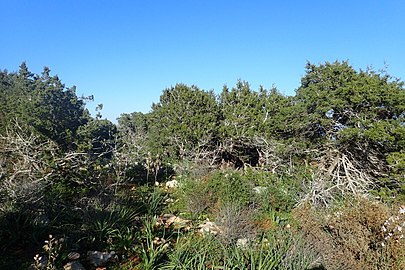| Juniperus turbinata | |
|---|---|

| |
| Capo Caccia, Sardinia | |
| Conservation status | |
 Near Threatened (IUCN 3.1) | |
| Scientific classification | |
| Kingdom: | Plantae |
| Clade: | Tracheophytes |
| Clade: | Gymnospermae |
| Division: | Pinophyta |
| Class: | Pinopsida |
| Order: | Cupressales |
| Family: | Cupressaceae |
| Genus: | Juniperus |
| Section: | Juniperus sect. Sabina |
| Species: | J. turbinata |
| Binomial name | |
| Juniperus turbinata Guss. | |
| Synonyms | |
List
| |
Juniperus turbinata is a woody plant in the family Cupressaceae.
The species was previously treated as part of Juniperus phoenicea, which is now regarded as restricted to Spain and France, whereas J. turbinata is found throughout the Mediterranean and in the Arabian Peninsula. As of 2023, plants occurring in the Canary Islands, previously considered as part of the same species, are treated as the separate species J. canariensis.
Description
Juniperus turbinata resembles J. phoenicea. It is a shrub or small tree up to 8 metres (26 feet) in height. The smaller branches have reddish bark. The adult leaves are scale-like, closely pressed to the twigs. Pollen is produced in the autumn (October to November), rather than in spring as in J. phoenicea. The seed cones are 7–11 millimetres (1⁄4–3⁄8 inch) long (longer than in J. phoenicea), and somewhat elongated, especially when immature. Each cone typically has 7–9 seeds (fewer than J. phoenicea).
-
 Foliage and cones
Foliage and cones
-
 In maquis shrubland habitat
In maquis shrubland habitat
Taxonomy
J. turbinata was first described by Giovanni Gussone in 1844. It has been treated as a variety or subspecies of J. phoenicea. DNA from populations previously assigned to J. phoenicea var. phoenicea and J. phoenicea var. turbinata was studied, and the results were published in 2013. It was found that the two taxa were clearly separated, and hence best treated as two species.
Distribution and habitat
J. turbinata has a native distribution throughout the Mediterranean and in the Arabian Peninsula. It is known from southwestern and southeastern Europe, North Africa, and parts of western Asia (Cyprus, the east Aegean Islands, Lebanon and Syria, the region of Palestine, the Sinai Peninsula) and northwestern Arabian Peninsula (Saudi Arabia). It favours soils that are composed of sand, Cambrian limestone or volcanic rock.
References
- Farjon, A. (2020). "Juniperus turbinata". IUCN Red List of Threatened Species. 2020: e.T16349692A179049709. doi:10.2305/IUCN.UK.2020-3.RLTS.T16349692A179049709.en. Retrieved 20 November 2021.
- ^ "Juniperus turbinata". Plants of the World Online. Royal Botanic Gardens, Kew. Retrieved 20 August 2023.
- "Juniperus canariensis". Plants of the World Online. Royal Botanic Gardens, Kew. Retrieved 21 August 2023.
- ^ Adams, Robert; Boratyński, Adam; Arista, Montserrat; Schwarzbach, Andrea; Leschner, Hagar; Liber, Zlatko; Minissale, Pietro; Mataraci, Tugrul & Manolis, Avramakis (2013), "Analysis of Juniperus phoenicea from throughout its range in the Mediterranean using DNA sequence data from nrDNA and petN-psbM: The case for the recognition of J. turbinata Guss." (PDF), Phytologia, 95 (2): 202–209, S2CID 4248085, BHL page 50927015
| Taxon identifiers | |
|---|---|
| Juniperus turbinata | |